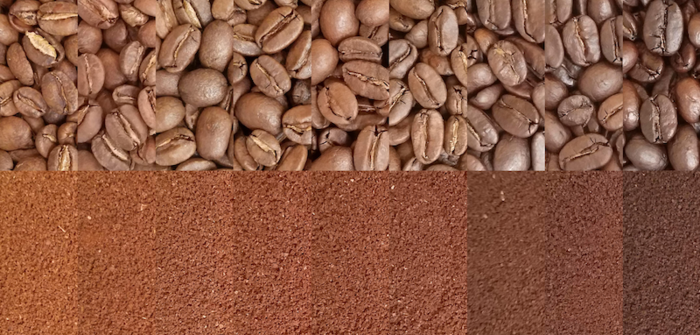
For these very dark roasts, most students tend to prefer the roast that looks like an S curve (get the coffee hot enough to get your dark roast flavor characteristics fast enough that you're not overly diminishing flavors developed earlier) and I suspect that will continue to be true this time around.
The fourth flight takes the darkest coffee from the first flight and adds variations where all the batches have the same total roasting time and match up to the start of first crack, but one goes faster through first crack and slower through second crack while the other goes slower through first crack and faster through second crack. Here again there are some clear differences in flavor.
This kind of exercise usually shows differences primarily in the intensity and expression of sweetness in the coffee. While an inexperienced taster might not know how to describe the differences on this one, they should be easily able to discern that there are differences among all the coffees in this flight, though they're more similar to each other than the coffees in the first flight due to the similar roast level.
The third flight takes the third coffee from the first flight and adds coffees that keep everything before the initial color change the same, everything after the coffee has turned brown the same, but goes faster or slower while the coffee is yellow in color.
(this is a practical example showing that DTR is a terrible metric that nobody should be using)
The 2nd flight might be the most difficult one for students. It's taking the lightest coffee from the first flight and doing two variations where the total time in the roaster is a minute less, but in one that's all front loaded where there isn't significant chemistry happening in the coffee and in the other it's divided proportionally through the entire roast so it looks the same in the percentage breakdowns.. There's a larger, but still subtle difference there.
The first flight is a basic roast level progression, and this is going to be an easy one for people to notice flavor differences. The third cup is a bit odd with sort of a bergamot-like flavor, but that's fine.
Tasting the coffees that I roasted yesterday for my next class. We're doing brewed pots of coffee first because that's going to be safer for everybody and second because we're dealing with roasting plans for production roasts and most people don't drink their coffee one spoon at a time out of a cupping bowl.
@jorge slackware from floppies.
@gnomon I keep telling people: vanilla and mulling spices. It's better.
PS. If you're creating a coffee roasting plan designer, please implement a relaxed cubic spline solver in that. It doesn't come out of the box with whatever GUI toolkit you're using, but it's not hard and it will work so much better than what you were going to try instead.
It's a cheap enough thing and it's only the one defect so while I can't sell it, it's also not worth the labor involved in getting a credit so I'm just going to take that home. While I have plenty of ways to make tea, shockingly they're all for a decent sized pot of tea. Nothing for making a small cup of tea, and this fixes that.
New tea infusers arrived today. One of these arrived in a functional but defective way. It's supposed to be a tea ball on a chain with a pink owl that can hang on the edge of the cup for easy tea removal. The pink base coat is there, but some parts are supposed to have white, black, or yellow highlights to make it more obvious that it's supposed to be a bird and not some sort of pink hell spawn.
- Software
- https://typica.us
- Send Money
- https://typica.us/payment.html
Author of Typica software for coffee roasters.
